Rabbi Brant Rosen, Shalom Rav, July 17, 2016
This past Friday, I had the honor to participate in an incredible, unprecedented mass action of civil disobedience in the H2 section of Hebron – in the heart of Israel's unjust and illegal occupation.
I'll start with a little bit of history:
In 1968, a year after Israel conquered the West Bank, a group of radical religious settlers led by Rabbi Moshe Levinger, led a group of followers to a hotel in Hebron – with the government’s support – to observe a Passover seder. When it was over, they refused to leave; and following a negotiation with the government, they were allowed to create a settlement to the east of Hebron that they named Kiryat Arba Since that time, Jewish settlers gradually moved into Hebron proper. Over the years tension gradually increased in Hebron. Things changed drastically in 1995 after Baruch Goldstein murdered 29 Muslim worshippers in the Ibrahimi mosque. Fearful of reprisals, the IDF imposed increasing curfews and restriction of movement on the Palestinian population.
In 1996, as part of the Oslo agreement, Hebron was divided into two sections: H1 and H2. H1 is locally governed by the Palestinian Authority and is home to approximately 120,000 Palestinians. Tens of thousands of Palestinians live in H2 along with 600 Jewish settlers. Since the Second Intifada, Israel increased their security crackdown on this part of the city, blocking off major streets to Palestinians – most notably the main commercial road, Shuhadah Street. (The army refers to them as “sterile roads”).
Virtually every Palestinian shop in H2 has been closed and their doors welded shut by the army. Because the Palestinian residents of Shuhadah St. are not allowed to walk on the road, they must enter and exit through the rear of homes because they cannot leave their own front doors. Because of these measures – and the ongoing harassment and violence at the hands of Jewish settlers – what was once the busting commercial center of Hebron has become a ghost town. 42% of its Palestinian homes are empty and 70% of its Palestinian business have been shut down.
We visited Hebron earlier this week and it was a truly chilling experience. Our group went on a tour led by Breaking the Silence, an organization of Israeli army veterans who are speaking out about the abuses the IDF are committing in Hebron. I did a BTF tour in 2008 during my first real foray into the reality of contemporary Hebron. Today, the situation there is even more dire if such a thing is possible.

With Colm Toibin in Hebron
Before we started our tour, we witnessed an incident in which a settler attacked an Israeli photographer and damaged his camera. As it turned out the photographer was the celebrated photojournalist Oren Ziv. who was accompanying a private BTS tour for Irish author Colm Tóibín. The incident was captured on film by a member of our delegation. He gave a copy of the video to Ziv so he could press charges against the settler for damages. (We never found out whether or not he actually succeeded).
As we walked down Shuhadah St., the intimidating presence of the settlers was impossible to ignore. At one point we saw Tóibín and his tour guide on the side of the road. A car with two settlers drove up and the driver proceeded to scream obscenities at them for ten minutes.
Hebron’s settlers are truly the most brutal, ideologically extreme and heavily armed of the entire settler movement. They walk and drive the streets with impunity and full protection of the IDF. As is the case throughout the West Bank, Jews are governed by Israeli civil law – and as a result the army cannot and does not intervene when settlers harass Palestinians. However, since Palestinians are subject to military law, they face dual oppression from soldiers and settlers alike.
After our BTS tour we walked to the Tel Rumeida neighborhood of Hebron to meet with Issa Amro, founder/director of Youth Against the Settlements. YAS is an increasingly powerful and important Palestinian nonviolent organization; among other things, it sponsors the annual Open Shuhadah Street campaign and regularly organizes/empowers the youth of Hebron.
Issa is truly a visionary leader in the Palestinian popular resistance movement. He has been arrested and detained countless times for his activism but has clearly become well known throughout Hebron as force to be reckoned with. Palestinian activists such as Issa tend to infuriate the Israeli military because their principled commitment to nonviolence cannot be quelled militarily. Although he and his comrades have been arrested and detained numerous times, YAS has come to represent a ray of hope for the Palestinian residents of Hebron.
We met Issa in the YAS center, which has an interesting history all its own. Originally Palestinian-owned, the building was taken over by settlers several years ago. But through a methodical campaign of legal pressure and nonviolent resistance, the settlers were eventually evicted and it was turned into YAS’s central headquarters. Last November, the center was raided by the IDF and temporarily declared a “closed military zone” (I’ll get back to this term later). Still, Issa and YAS remain steadfast.
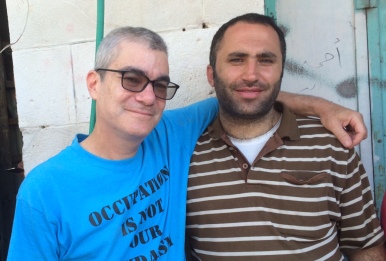
With Issa Amro of Youth Against the Settlements
On Thursday we prepared to return to Hebron for our nonviolent direct action, which had been almost two years in the planning by YAS and the Israeli anti-occupation collective All That’s Left. The Center for Jewish Nonviolence was invited to be part of this action as well so that its message could be strengthened through the solidarity of diaspora Jewry. CJNV has cultivated a strong relationship with both YAS and ATL and other Israeli/Palestinian partners on the ground. It is truly a sign of the times that diaspora Jews are joining this increasingly broad-based solidarity movement.
The goal of the action was to begin the process of turning an old metal factory in the Tel Rumeida neighborhood of Hebron into a movie theater: Cinema Hebron.YAS chose to build a movie theater so that the isolated, segregated Palestinian residents of H2 could have a place to come together in community – to experience even a little slice of normalcy in this intensely abnormal, unjust environment. It was also designed to be a statement to the settler community that the Palestinian residents of Hebron will continue to resist the theft of their property – and that Jews from around the world are ready to stand in solidarity with them.
The factory is owned by Jawad Abu Aisha, the patriarch of a prominent family in Tel Rumeida. As was the case with the YAS center, Jewish settlers were gradually encroaching toward this particular property – and based on past history, it seemed it was only a matter of time before it was taken it over completely. Tel Rumeida is heavily desired by settlers and has long been one of the tensest areas of Hebron. (This past March, Tel Rumeida made the news after a solider was filmed shooting a wounded Palestinian in the head while he was lying in the street.)
We spent all day Thursday preparing for the action, which was prepared down to the most minute detail. Our plan was to go to the old, cluttered site, begin the process of cleaning it up and announce our intention to turn it into Cinema Hebron to the press. Inevitably the IDF and police would show up and eventually declare it a “closed military zone” – their standard operating procedure when dealing with protests.
Legally speaking, the military needs to get a signed order to declare a closed military zone, but they often dispense with that pretense. Our plan was to keep cleaning up the site until the soldiers returned with their order. In the meantime, we would put up a mock marquee, pass out Cinema Hebron popcorn, give interviews to press, chant and sing, and do our best to clean up the site before they soldiers and police ordered us out.
There were 60 participants all told – 40 from CJNV and another twenty from Youth against the Settlements and All That’s Left. Our group split up into three “pods” – Green (those who would work until the soldiers returned but would not take an arrest), Yellow (those who would would be willing to be arrested if it was deemed necessary by our leaders) and Red (those who would stay until they were arrested.)
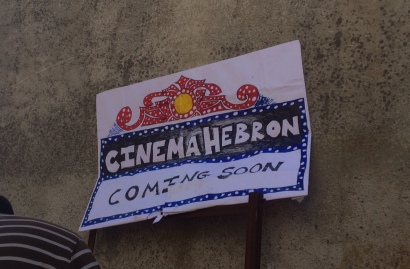 As an extra precautionary measure, we drove to the site in separate vans to the site. Unfortunately, the military was somehow tipped off that there was some kind of action being planned for Hebron that day – and the van coming with ATF activists from Jerusalem was stopped en route. Our CJNV delegation all made it in safely, however. We gathered in an old metal warehouse until we were given the word that our tools had arrived. Then we put up the marquee and got to work.
As an extra precautionary measure, we drove to the site in separate vans to the site. Unfortunately, the military was somehow tipped off that there was some kind of action being planned for Hebron that day – and the van coming with ATF activists from Jerusalem was stopped en route. Our CJNV delegation all made it in safely, however. We gathered in an old metal warehouse until we were given the word that our tools had arrived. Then we put up the marquee and got to work.
The site was heavily overgrown with high weeds and all kinds of scrap metal everywhere. As we started raking, hauling, piling junk we sang a every Jewish song and civil rights chant we knew. In short order settlers started to gather, peering at us through the front gate. The IDF and police arrived soon as well – we worked for about an hour or an hour and a half before they actually entered the site. They began arguing with the Palestinian owners and after some back and forth, they eventually fell back and we continued with our work.
After another hour or so, they returned and announced that the area was a closed military zone. At this point some members of our delegation left and the rest of us sat down in the middle of the site, continuing to chant and sing. A police officer came up to us and told us that our presence on the site was illegal and if we did not leave in two minutes, we would be arrested (below). When our two minutes were up, they started to physically remove us (see the clip at the top of this post). They shoved us to the back of the site, gathered us together and ordered us to take out our passports. They then asked the six Israelis from our delegation to take out their identity cards and led them away. We were sent out in the other direction and told to leave the site.
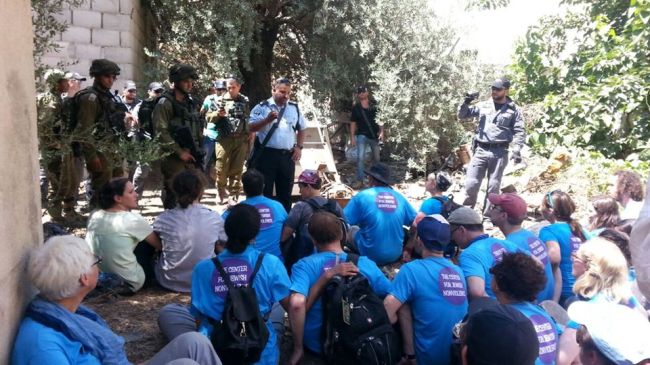
Photo: A. Daniel Roth – http://allthesedays.org
At that point we gathered together and discussed what to do next. It seemed clear to us that the Israelis were targeted because they were easier to process – and that the authorities likely wanted to avoid the bad publicity of arresting internationals. When we received word from our lawyers that our six friends had been taken to the police station in Kiryat Arba, we decided to walk there together and demand their release.
After walking for only ten minutes or so we were stopped by five soldiers who told us we couldn’t continue because the area was (you guessed it) a closed military zone. We refused to leave and said we simply wanted to visit our friends in the police station. Thus began a stand off, during which the lead soldier called his commander four or five times. They clearly had never dealt with a group like ours and were somewhat bewildered that we wouldn’t leave when ordered. Finally Issa arrived and argued loudly with the soldiers. I’m not sure how he managed it but we were finally told we could continue along a detoured route.
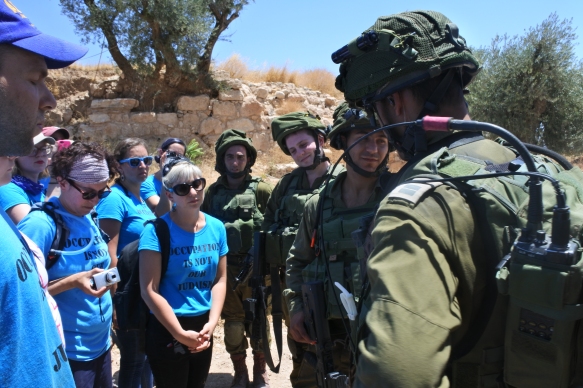
We eventually made it to Shuhadah St., continued down the road, passed the Ibrahimi Mosque and headed up a hill that led us in the direction of Kiryat Arba. As we walked in, we were joined by soldiers who silently walked alongside us. It quickly became clear to me that they weren’t there to impede us but rather to protect us from angry settlers. (I’m fairly sure this was the first time the residents of Kiryat Arba had ever witnessed a group of singing diaspora Jews walking down the street wearing “Occupation in Not Our Judaism” T-shirts ).
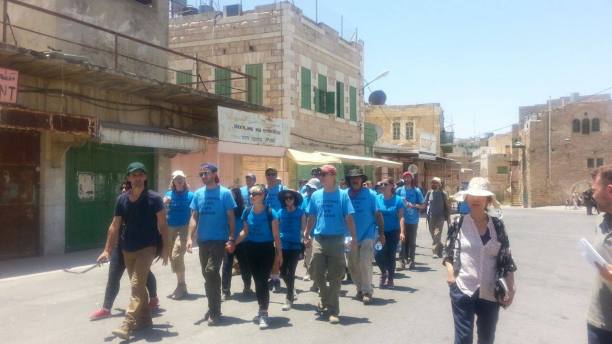
Photo: A. Daniel Roth – http://allthesedays.org
We finally arrived at a gated area and faced yet another gauntlet of soldiers. After yet another round of back and forth, we were sent around to the front gate. Then we walked down a residential community to the end of the street where the police station was located. We talked to the guard at the front gate and explained we wanted to see our friends inside. After other policemen gathered we were told that our six friends were indeed inside but that we would not be allowed to see them. At this point, increasing numbers of residents from the neighborhood had come to mock and taunt us. Many of them filmed us with their cell phones. Eventually we sat down on the ground in front of the station gate and began to sing and chant once more.
The leaders of our delegation were in cell phone contact with the lawyers and our friends inside, who told us they could actually hear us singing and calling out their names. They were in the process of being interrogated by the police one by one but were otherwise fine. By this point quite a crowd had started to gather around us. We kept on singing as more police cars arrived. The original officer came back to us and told us that this was an illegal assembly – and that we had two minutes to disperse before they arrested us.
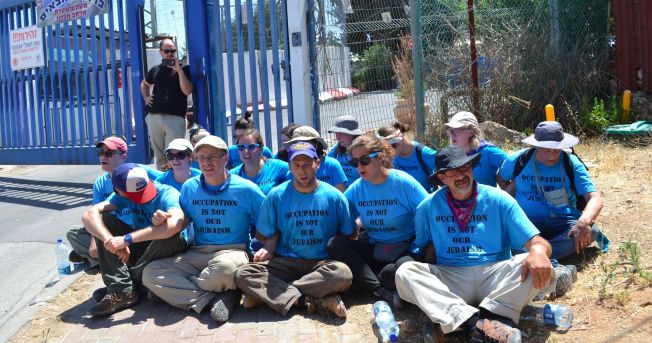
Photo credit: Jewish Forward
After talking with our lawyers, we decided against taking an arrest. They told us they believed our friends would likely be released in several hours, adding that our arrest would not help their cause and might even hinder it. So after spending an hour at the station we got up, walked together down the street and gathered near the front gate. As Shabbat was getting closer, we sang Shalom Aleichem and Lecha Dodi together with our other songs. Then together, we walked to a YAS home in H1 to meet up with the rest of our crew, eat a late lunch, debrief, share stories and nap after our physically/emotionally exhausting experience. Eventually we boarded our bus and returned to Susiya, in the South Hebron Hills where we would spend our Shabbat.
That evening just after a gorgeous sunset, we made a circle on a rocky hill and I began to lead our Shabbat service. As I prepared to lead Lecha Dodi, the prayer that welcomes the Shabbat bride, I heard someone shout. I looked up and saw two cars pulling up. Our six friends got out, grinning ear to ear as we cheered their arrival. After lots of hugs and laughter, we all continued with our service.
Shabbat had arrived.
(PS: You can read about our Cinema Hebron action here and here and our Shabbat in Susiya here).